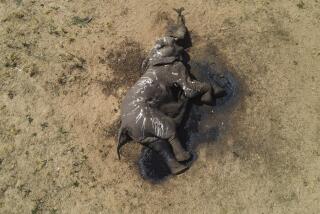Army Poachers Peril Wildlife in Uganda
- Share via
KAMPALA, Uganda — Army poaching is among the worst problems for those trying to rescue Uganda’s national parks and wildlife preserves from decades of war.
Uganda has six national parks and 11 wildlife sanctuaries. The largest and best-known, Murchison Falls in the northwest, is the most threatened.
Park officials say soldiers from nearby Karuma Army Barracks go into the park to kill hippos, zebras and giraffes for food, frightening many others away in the process.
“We have a serious problem with the army,” said Eric Edroma, director of national parks, who said soldiers do more game poaching than civilians.
“Time and again we have appealed to barracks commanders and senior army officers to restrain the army, but the message has gone on deaf ears,” Edroma said in an interview.
Fred Muhumuza, a spokesman for the parks department, said soldiers from Karuma sometimes “come down on a truck and start shooting,” and park rangers “are careful how we approach them.”
Edroma said soldiers shoot an average of four hippopotamus a month in Murchison Falls Park. Although that is not enough to cause a decline in the herd, the park director said, he worries that the slaughter will increase.
Hippos have a relatively high birthrate. The park had 15,000 in 1985, Edroma said, and their numbers have increased to 20,000 despite the poaching.
But that isn’t true for other threatened animals. In the third-largest national park, Kidepo near the frontier with Sudan, only five giraffes are known to have survived from the 50 to 60 three years ago, Edroma said.
“There is near-permanent insecurity in that park,” Muhumuza said. “Animals killed by soldiers and cattle rustlers are beyond our estimates because insecurity prevents us from proper surveillance.”
Both soldiers and civilians invaded game parks with impunity before President Yoweri Museveni seized power in early 1986, but soldiers have been the main threat to game for 20 years. The army slaughter, especially of elephants, escalated after former dictator Idi Amin took power in 1971.
Amin, then the army chief of staff, was implicated in an ivory-smuggling scandal shortly before he ousted President Milton Obote. Once in power, he tolerated ivory smuggling by officers.
From an estimated 17,620 in 1973, the elephant population of this East African country declined to 4,190 in 1977, two years before Amin was overthrown.
By 1987, when Museveni established some order and conservationists could function again, only about 1,000 remained. The creatures have made something of a comeback; Edroma said the current population is estimated at 3,000.
A worldwide ban on ivory trading imposed in 1990 has contributed to the decrease in elephant poaching, he said.
Rhinos weren’t so lucky. White or black rhinos never were abundant in Uganda and the highest number ever, 38, was recorded 1974-75. Poachers killed all of them for their horns, valued as an aphrodisiac in the Far East and for dagger handles in the Middle East.
“The last rhino, a white one, was seen in 1985,” Edroma said. “We are making arrangements to import new stocks from Zaire if funds are available.”
But even the most dedicated conservationists can’t guarantee success. Only the government can control the army, Edroma said.
More to Read
Sign up for Essential California
The most important California stories and recommendations in your inbox every morning.
You may occasionally receive promotional content from the Los Angeles Times.










